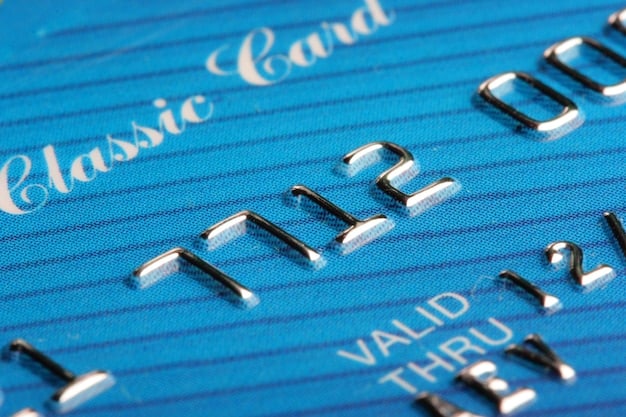Credit Card Interest Rates 2025: Your Ultimate Buying Guide

Understanding credit card interest rates is paramount for American consumers in 2025 as they navigate an evolving financial landscape, requiring a strategic approach to minimize costs and maximize financial health.
Navigating the complex world of credit card interest rates can feel like deciphering an intricate financial code, especially as we look towards 2025. This comprehensive Buying Guide: Understanding Credit Card Interest Rates and How to Minimize Them in 2025 aims to illuminate the nuances of these charges, equipping you with the knowledge and strategies to manage your credit effectively and minimize unnecessary expenses.
The Anatomy of Credit Card Interest Rates: Basics and Beyond
Credit card interest rates, often referred to as Annual Percentage Rates (APRs), represent the cost of borrowing money from a credit card issuer. This seemingly straightforward concept holds multiple layers, as not all APRs are created equal. In 2025, understanding these distinctions is more crucial than ever for managing personal finances effectively.
The primary APR is what most consumers consider the standard interest rate applied to outstanding balances. However, beyond this generalized rate, various other APRs can come into play, each with its own conditions and implications for your financial well-being. Dissecting these different types helps consumers make informed decisions and avoid unexpected costs.
Understanding Different APR Types
Credit cards often feature a hierarchy of interest rates, designed to apply to different types of transactions. Knowing which rate applies when can significantly impact the total cost of your credit usage. It’s a fundamental aspect of savvy credit management.
- Purchase APR: This is the most common rate, applied to new purchases if the balance carried past the grace period.
- Cash Advance APR: Typically higher than the purchase APR, this rate applies to cash withdrawals made using your credit card, often with no grace period.
- Balance Transfer APR: A specific rate applied to balances transferred from one card to another, usually lower for promotional periods.
- Penalty APR: A significantly higher rate that can be imposed if you violate terms, such as making late payments.
Grace Periods and Their Importance
A grace period is the time between the end of a billing cycle and the date your payment is due. During this period, no interest accrues on new purchases, provided you pay your balance in full by the due date. This makes understanding your grace period vital to avoiding interest charges altogether on your purchases. Not all transactions qualify for a grace period, such as cash advances, which usually accrue interest from day one.
For savvy consumers in 2025, maximizing the grace period means paying your full statement balance on time, every time. This practice is the cornerstone of responsible credit card use, allowing you to leverage credit for convenience and rewards without incurring interest debt. Failing to understand or utilize the grace period can lead to a cycle of mounting interest charges, making it harder to pay down your balance.
Factors Influencing Your Credit Card Interest Rate in 2025
Several variables contribute to the interest rate you’ll be offered on a credit card in 2025. These factors range from your personal financial history to broader economic indicators, making the process of rate determination complex and dynamic. Understanding these influences can empower you to improve your standing and secure more favorable terms.
The interplay of these elements means that your credit card interest rate isn’t a static number. It’s a reflection of perceived risk from the issuer’s perspective, combined with market conditions. Therefore, improving your personal financial profile and staying aware of economic trends can yield significant benefits.
Your Credit Score: The Primary Determinant
Your credit score is arguably the most significant factor affecting the interest rate you’re offered. A higher credit score signals a lower risk to lenders, making you eligible for cards with lower APRs and better terms. This numerical representation of your creditworthiness is built upon your payment history, credit utilization, length of credit history, new credit, and credit mix.
Maintaining an excellent credit score, generally considered to be 750 or above, is critical. It demonstrates your ability to manage debt responsibly, making you an attractive borrower. Conversely, a poor credit score can lead to offers with very high interest rates, making credit expensive and potentially difficult to manage.
Economic Indicators and the Prime Rate
Beyond individual creditworthiness, macroeconomic factors play a crucial role. The prime rate, which is the interest rate commercial banks charge their most creditworthy corporate customers, directly influences credit card APRs. When the Federal Reserve adjusts the federal funds rate, the prime rate typically moves in tandem, and credit card interest rates follow suit.

This means that even if your credit score remains stable, your credit card APR can fluctuate based on broader economic policies and market conditions. Staying informed about the Federal Reserve’s decisions and general economic forecasts can provide insight into potential changes in your credit card interest rates, allowing for proactive financial planning.
Inflationary pressures, global economic health, and consumer spending trends also subtly influence the lending environment. Lenders adjust their risk models and pricing based on these wider economic currents, underscoring the interconnectedness of your personal finance with the global economy.
Strategies for Minimizing Credit Card Interest in 2025
While interest rates are an inherent part of credit cards, there are numerous proactive steps you can take to minimize the amount you pay in interest. These strategies range from diligent payment habits to strategic utilization of credit card features, all aimed at protecting your financial health in 2025.
Implementing these practices can not only save you money but also strengthen your overall financial discipline. It’s about being intentional with your credit usage, turning potential liabilities into powerful financial tools.
Pay Your Balance in Full and On Time
The most effective strategy to avoid credit card interest is to pay your statement balance in full every month. By doing so, you leverage the grace period, meaning new purchases won’t accrue interest. This habit is the cornerstone of interest-free credit card usage and should be your primary goal.
- Set up autopay: Ensure payments are never missed.
- Monitor your statements: Catch any discrepancies early.
- Adjust spending habits: Align spending with your payment capacity.
Even if paying your full balance isn’t always feasible, always making at least the minimum payment on time is critical. Late payments not only incur fees but can also trigger a penalty APR, significantly increasing your cost of credit and damaging your credit score. Timeliness is as important as the amount paid.
Strategic Balance Transfers and Promotional APRs
Balance transfer credit cards offer a promotional 0% APR for a set period, typically 6 to 18 months. This can be an excellent strategy to pay down high-interest debt, as all your payments go directly to the principal during the promotional period. However, it’s crucial to understand the terms and conditions, including any balance transfer fees, before proceeding.
When considering a balance transfer, create a realistic payment plan to ensure you can pay off the transferred balance before the promotional period expires. If you don’t, any remaining balance will be subject to the standard, often higher, APR. Use these offers sparingly and strategically, not as a perpetual solution to debt.
Negotiating Your Interest Rate
Many consumers are unaware that credit card interest rates can be negotiable. If you have a good payment history, a solid credit score, and have been a long-time customer, contacting your credit card issuer to request a lower APR can be a worthwhile endeavor. Highlight your positive payment behavior and loyalty.
While there’s no guarantee of success, many issuers are willing to work with reliable customers to retain their business. This simple phone call could potentially save you hundreds of dollars in interest over time. Persistence and presenting a clear case for your request can increase your chances of a favorable outcome.
Advanced Tactics for Credit Card Management in 2025
Beyond the fundamental strategies, there are more nuanced and advanced tactics consumers can employ to optimize their credit card usage and minimize interest in 2025. These approaches require a deeper understanding of personal finance and a commitment to disciplined execution.
From leveraging specific card features to understanding the psychology of personal spending, these advanced tactics offer pathways to greater financial efficiency and control, transforming credit cards from potential liabilities into strategic assets.
Understanding Average Daily Balance Calculation
Most credit card issuers use the average daily balance (ADB) method to calculate interest charges. This means that the interest is calculated based on the average of your daily balances during the billing cycle. Even small payments made throughout the month, rather than waiting for the due date, can slightly reduce this average daily balance and theoretically lower your interest charges.
While the impact of mid-cycle payments might be marginal for those who pay their balance in full, it becomes more significant if you carry a balance. Understanding this calculation method can influence when and how often you make payments, providing another layer of control over your interest expenses.
Credit Utilization Ratio Management
Your credit utilization ratio— the amount of credit you’re using compared to your total available credit—significantly impacts your credit score. A low utilization ratio (ideally below 30%) indicates responsible credit management and can indirectly help you unlock better APR offers in the future by improving your credit score. Keeping balances low across all your cards is paramount.
Even if you pay your bill in full, a high utilization ratio reported before your statement date can temporarily lower your credit score. To avoid this, consider making extra payments before your statement closes, especially if you anticipate hitting high utilization. This proactive approach helps maintain a desirable credit score profile.
Automating Payments and Alerts
In the digital age, automation is a powerful ally. Setting up automatic payments ensures you never miss a due date, safeguarding your credit score and avoiding late fees and penalty APRs. Beyond payments, setting up alerts for approaching due dates, high spending, or unusual activity provides an extra layer of security and control.

These alerts serve as timely reminders and early warnings, allowing you to react quickly to potential issues. In 2025, leveraging technology for financial management isn’t just convenient; it’s a critical component of minimizing debt and maximizing savings, ensuring you’re always one step ahead of your credit card obligations.
Common Pitfalls and How to Avoid Them in 2025
Despite best intentions, consumers often fall into common traps when managing credit cards, leading to unnecessary interest charges and financial stress. Recognizing these pitfalls is the first step toward avoiding them, ensuring your credit card usage remains a tool for convenience rather than a source of debt accumulation in 2025.
Proactive avoidance of these mistakes requires both discipline and a clear understanding of how credit card systems operate. By being aware of these common missteps, you can navigate your financial landscape with greater confidence and less financial burden.
Falling for Minimum Payment Traps
Paying only the minimum amount due on your credit card each month is one of the most common and costly mistakes. While it keeps your account in good standing and avoids late fees, it significantly prolongs the repayment period and dramatically increases the total interest paid over the life of the debt. The minimum payment is designed to keep you indebted for as long as possible.
Always strive to pay more than the minimum, preferably the full balance. If that’s not possible, pay as much as you can comfortably afford beyond the minimum. This accelerated repayment strategy directly reduces your principal faster, leading to less interest accruing over time and getting you out of debt sooner.
Ignoring Credit Card Statements
It can be tempting to glance at a credit card statement only to check the amount due, but ignoring the details is a significant oversight. Statements contain vital information: your interest rate, breakdown of charges, payment history, and any fees applied. Reviewing them thoroughly can help you spot errors, identify areas of overspending, and understand where your money is going.
Missing discrepancies or failing to comprehend the charges listed can lead to unexpected interest or fees. In 2025, regular and meticulous review of your credit card statements is a basic but powerful form of financial self-auditing, essential for maintaining control and minimizing costs.
Impulse Spending and Over-utilization
Credit cards offer immediate purchasing power, which can lead to impulse spending and over-utilization of available credit. This not only increases your outstanding balance, leading to more interest, but also negatively impacts your credit utilization ratio, potentially harming your credit score. Living beyond your means via credit cards is a fast track to financial distress.
Establish a budget and stick to it. Treat your credit card as a convenient payment method, not an extension of your income. Regularly assess your spending habits and ensure they align with your repayment capacity. Self-discipline is key to harnessing the benefits of credit cards without falling prey to their potential pitfalls.
Future Trends in Credit Card Interest Rates for 2025
Looking ahead to 2025, several trends could influence credit card interest rates and the overall financial landscape. Staying abreast of these potential shifts can help you anticipate changes and adjust your financial strategies accordingly, ensuring you remain financially resilient.
Potential Economic Shifts and Regulatory Changes
The global and domestic economic environments are constantly evolving. Policies from the Federal Reserve, inflation rates, and employment figures all play a significant role in determining the direction of interest rates. It’s plausible that we could see continued volatility or stabilization, directly impacting the cost of borrowing.
Moreover, regulatory bodies may introduce new rules or protections for consumers, potentially affecting how interest rates are calculated or applied. Staying informed about these macroeconomic shifts and policy changes is crucial for proactive financial planning and understanding the context in which your credit card operates.
The Rise of AI in Credit Lending
Artificial intelligence (AI) is increasingly being integrated into credit lending decisions. By analyzing vast amounts of data, AI algorithms can assess creditworthiness with greater precision, potentially leading to more personalized interest rates tailored to individual risk profiles. This could mean more competitive rates for those with excellent financial habits and potentially higher rates for others.
This technological evolution might also lead to faster credit approval processes and more dynamic rate adjustments based on an individual’s real-time financial behavior. Embracing financial literacy in the age of AI will be paramount, as your digital financial footprint may play an even larger role in determining your access to credit and its cost.
Personalized Offers and Consumer Behavior
As credit card companies become more sophisticated in data analysis, consumers might see an increase in highly personalized offers, including bespoke interest rates and reward structures. These offers will be shaped not just by traditional credit scores but also by individual spending patterns, loyalty, and engagement with financial products.
This trend underscores the importance of cultivating positive financial behaviors. Consistently managing your credit well will likely open doors to more favorable terms and exclusive benefits. Conversely, inconsistent behavior could lead to less attractive offers. In 2025, your financial conduct will speak louder than ever in the credit marketplace.
| Key Point | Brief Description |
|---|---|
| 📊 Understand APRs | Different APRs (purchase, cash advance, balance transfer, penalty) apply to various transactions. |
| 📈 Credit Score Impact | Your credit score is the prime factor influencing the interest rate you receive. |
| 💳 Pay in Full | Paying your balance in full each month is the most effective way to avoid interest charges. |
| 🔮 Future Trends | Economic shifts and AI integration will shape interest rates and personalized offers in 2025. |
Frequently Asked Questions
▼
A good credit card interest rate generally falls between 15% and 20% for those with excellent credit. However, in 2025, rates can fluctuate based on the prime rate and economic conditions. Ideally, aim for the lowest possible APR, especially if you anticipate carrying a balance, or focus on cards with promotional 0% APR offers for specific periods.
▼
Your credit score is a primary indicator of your creditworthiness to lenders. A higher score signifies a lower risk of default, often qualifying you for lower interest rates. Conversely, a lower score suggests a higher risk, leading to higher APRs. Maintaining a strong credit score through timely payments and low utilization is crucial for securing favorable rates.
▼
Yes, it’s often possible to negotiate your credit card interest rate. If you have a good payment history, a high credit score, and have been a loyal customer, contact your credit card issuer to request a lower APR. While not guaranteed, many issuers are willing to adjust rates to retain valuable customers, especially if you have competing offers.
▼
A grace period is the time between the end of your billing cycle and your payment due date, during which no interest accrues on new purchases if you pay your statement balance in full. It’s critical because it allows you to use your credit card interest-free. By consistently paying your full balance on time, you effectively avoid all purchase interest charges.
▼
In 2025, AI is expected to lead to more personalized interest rates. AI algorithms analyze vast amounts of data to assess individual risk beyond traditional credit scores, potentially offering highly tailored APRs based on spending habits and financial stability. This could mean more competitive rates for low-risk borrowers, emphasizing the importance of responsible financial behavior.
Conclusion
Mastering credit card interest rates in 2025 is more than just understanding numbers; it’s about adopting proactive financial behaviors and leveraging strategic tools to minimize costs. By diligently paying balances, strategically using promotional offers, and staying informed about economic trends, consumers can transform credit cards from potential liabilities into powerful instruments for financial growth and convenience. The journey to smart credit management is continuous, but with the right knowledge and discipline, you can navigate the financial landscape of 2025 with confidence and control.





